- Details
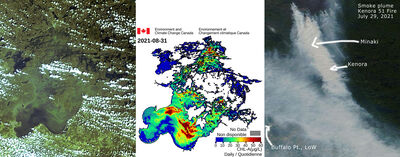 The seasonal algae bloom on Lake of the Woods is underway and has progressed up into the north end of the lake, as shown in the satellite image and associated derived chlorophyll-a data for August 31.
The seasonal algae bloom on Lake of the Woods is underway and has progressed up into the north end of the lake, as shown in the satellite image and associated derived chlorophyll-a data for August 31.
For much of the summer, it seemed like a "light year" for algae blooms, but blooms began to develop in mid-to late August. The low blooms in much of the mid-summer may perhaps be due to the low water and low flows from the nutrient-rich southern basin of Lake of the Woods, or perhaps lower light conditions due to the intense smoke that blanketed the lake throughout July and into the first week of August. The smoke conditions also likely limited the days for which the satellite tools could generate good chlorophyll-a estimates. The satellite tools, developed by Dr. Caren Binding at Environment and Climate Change Canada, hold much promise for long-term monitoring of trends in algae bloom intensity and severity.
- Details
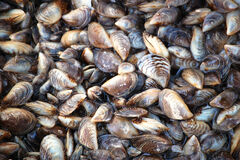 Disappointing news. Zebra mussel larvae have been confirmed in Rainy Lake by the Minnesota Department of Natural Resources (MNDNR). The larvae were found in four of five water samples taken in July 2021, suggesting that there is a reproducing population in the lake according to MNDNR. This follows on an unconfirmed report of larvae in 2020 by a member of the public. Locations of adult reproductive colonies have not yet been located or confirmed. Rainy Lake straddles the Ontario-Minnesota border and flows downstream via the Rainy River to Lake of the Woods.
Disappointing news. Zebra mussel larvae have been confirmed in Rainy Lake by the Minnesota Department of Natural Resources (MNDNR). The larvae were found in four of five water samples taken in July 2021, suggesting that there is a reproducing population in the lake according to MNDNR. This follows on an unconfirmed report of larvae in 2020 by a member of the public. Locations of adult reproductive colonies have not yet been located or confirmed. Rainy Lake straddles the Ontario-Minnesota border and flows downstream via the Rainy River to Lake of the Woods.
This follows equally concerning confirmations by MN DNR in 2019 and 2020 of zebra mussel larvae at several sites in the southern portion of Lake of the Woods.
- Details
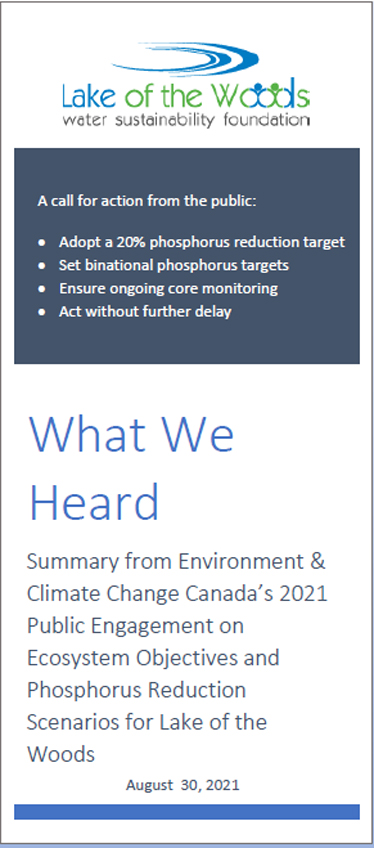 LOWWSF has released a report summarizing what we heard from the public during engagement sessions with Environment and Climate Change Canada on its set of proposed lake ecosystem objectives and potential phosphorus reduction scenarios to improve water quality for Lake of the Woods. Hundreds participated in ten webinars and online via ECCC's Lake of the Woods engagement website. The messages were clear and a call to action -- "get on with it":
LOWWSF has released a report summarizing what we heard from the public during engagement sessions with Environment and Climate Change Canada on its set of proposed lake ecosystem objectives and potential phosphorus reduction scenarios to improve water quality for Lake of the Woods. Hundreds participated in ten webinars and online via ECCC's Lake of the Woods engagement website. The messages were clear and a call to action -- "get on with it":
- Adopt a 20% phosphorus reduction target
- Set binational phosphorus targets
- Ensure ongoing core monitoring
- Act without further delay
- Details
 It seems just like yesterday, but it’s been seven years since the last Rainy-Lake of the Woods State of the Basin Report (SOBR) was published. Since 2014, we have learned a lot about our lake, its watershed and the priority concerns about water quality, invasive species, nutrients and toxic algae, and much, much more.
It seems just like yesterday, but it’s been seven years since the last Rainy-Lake of the Woods State of the Basin Report (SOBR) was published. Since 2014, we have learned a lot about our lake, its watershed and the priority concerns about water quality, invasive species, nutrients and toxic algae, and much, much more.
In June, we launched a major project to update the State of the Basin Report to 2021, in a multi-jurisdictional collaboration led by the Lake of the Woods Water Sustainability Foundation, with the Territorial Planning Unit of Grand Council Treaty #3, members of the International Multi-Agency Arrangement (government agencies, U.S. Tribal, non-governmental organizations), and the International Joint Commission watershed Board.
Publication of the SOBR 2021 Edition is planned for March 2022.
- Details
by Bev Clark, for the Lake of the Woods Water Sustainability Foundation
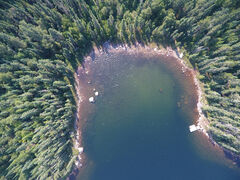 If you are concerned about algal blooms in Lake of the Woods or algal blooms anywhere for that matter, then you will hear a great deal about phosphorus concentrations and phosphorus loads. The difference is almost straightforward.
If you are concerned about algal blooms in Lake of the Woods or algal blooms anywhere for that matter, then you will hear a great deal about phosphorus concentrations and phosphorus loads. The difference is almost straightforward.
In this article, Bev demystifies the talk about phosphorus and its relationship to algae and how it relates to the types of lakes in our region, ranging from the ultra-clear waters of Lake 224 pictured here to the algae laden green waters of the south end of Lake of the Woods
(Lake 224 photo courtesy of the IISD Experimental Lakes Area)
- Details
 Great news for Lake of the Woods in Canada’s Budget 2021. The federal Budget included $1.8 million for Lake of the Woods. This is bridging funding for the current year only, but will allow Environment and Climate Change Canada to maintain research and monitoring activities and continue efforts towards developing phosphorus pollution reduction targets to address toxic algae in the lake. We anticipate that further funding will follow, likely as part of the large-lakes mandate of the Canada Water Agency, currently being established.
Great news for Lake of the Woods in Canada’s Budget 2021. The federal Budget included $1.8 million for Lake of the Woods. This is bridging funding for the current year only, but will allow Environment and Climate Change Canada to maintain research and monitoring activities and continue efforts towards developing phosphorus pollution reduction targets to address toxic algae in the lake. We anticipate that further funding will follow, likely as part of the large-lakes mandate of the Canada Water Agency, currently being established.
- Details
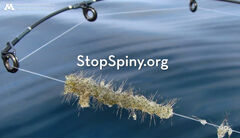 Spiny waterfleas are small aquatic predators native to Eurasia. The first report of spiny waterfleas in North America was in Lake Ontario in 1982 and was introduced to the Great Lakes in ballast water from ocean-going ships. “Spiny” is a species of zooplankton – small animals that rely on water currents and wind to move long distances. They prefer large, deep, clear lakes, but can also be found in shallower waters.
Spiny waterfleas are small aquatic predators native to Eurasia. The first report of spiny waterfleas in North America was in Lake Ontario in 1982 and was introduced to the Great Lakes in ballast water from ocean-going ships. “Spiny” is a species of zooplankton – small animals that rely on water currents and wind to move long distances. They prefer large, deep, clear lakes, but can also be found in shallower waters.
- Details
 LakeSmart is an award-winning environmental outreach program unique to the Lake of the Woods area of northwestern Ontario. A signature program of the our sister organization, the Lake of the Woods District Stewardship Association (LOWDSA), it is focused on environmental education and helping lake users “live and play green” at the lake. The LakeSmart Boat is now launched and the team looks forward to visiting you.
LakeSmart is an award-winning environmental outreach program unique to the Lake of the Woods area of northwestern Ontario. A signature program of the our sister organization, the Lake of the Woods District Stewardship Association (LOWDSA), it is focused on environmental education and helping lake users “live and play green” at the lake. The LakeSmart Boat is now launched and the team looks forward to visiting you.
To contact the LakeSmart team or to book a visit: email
